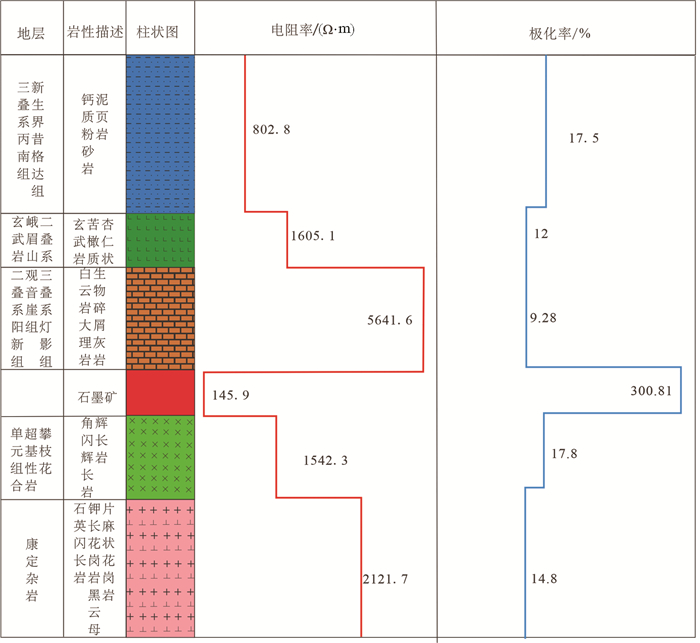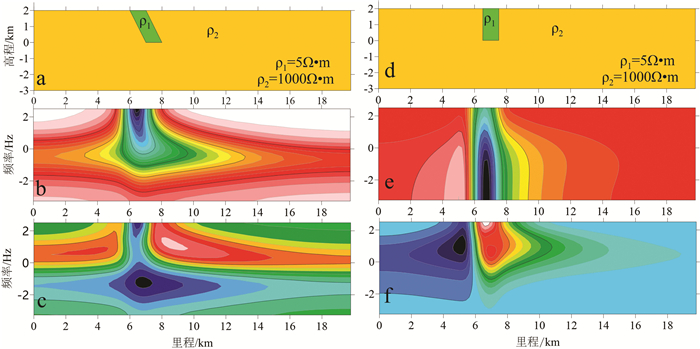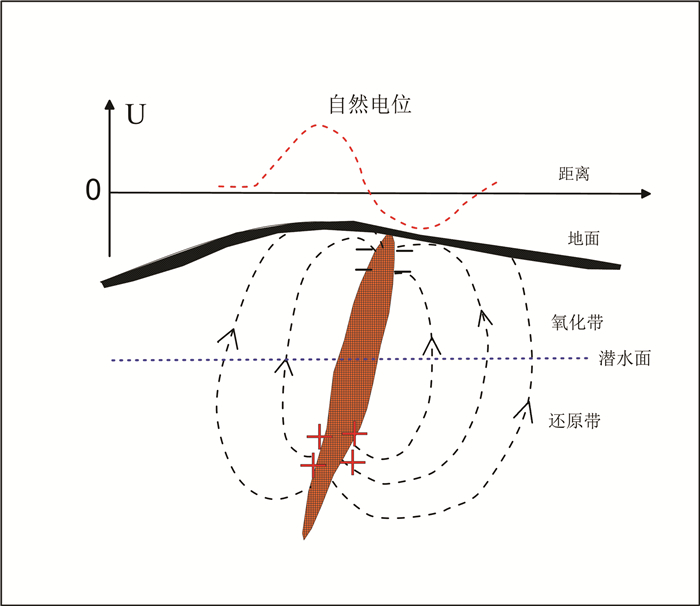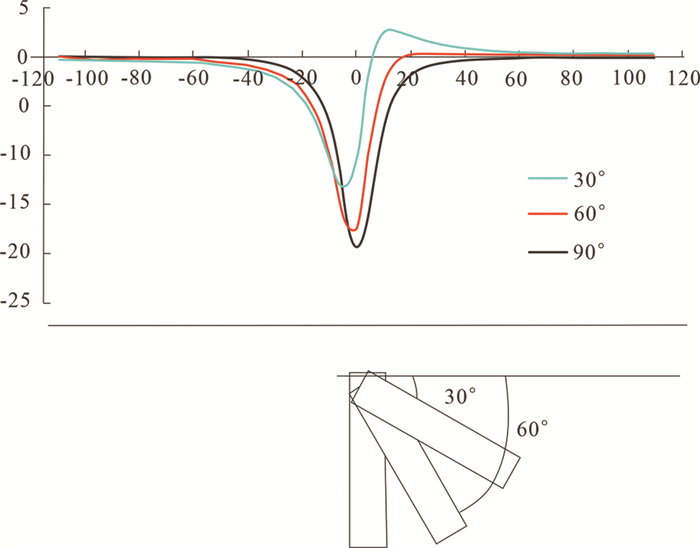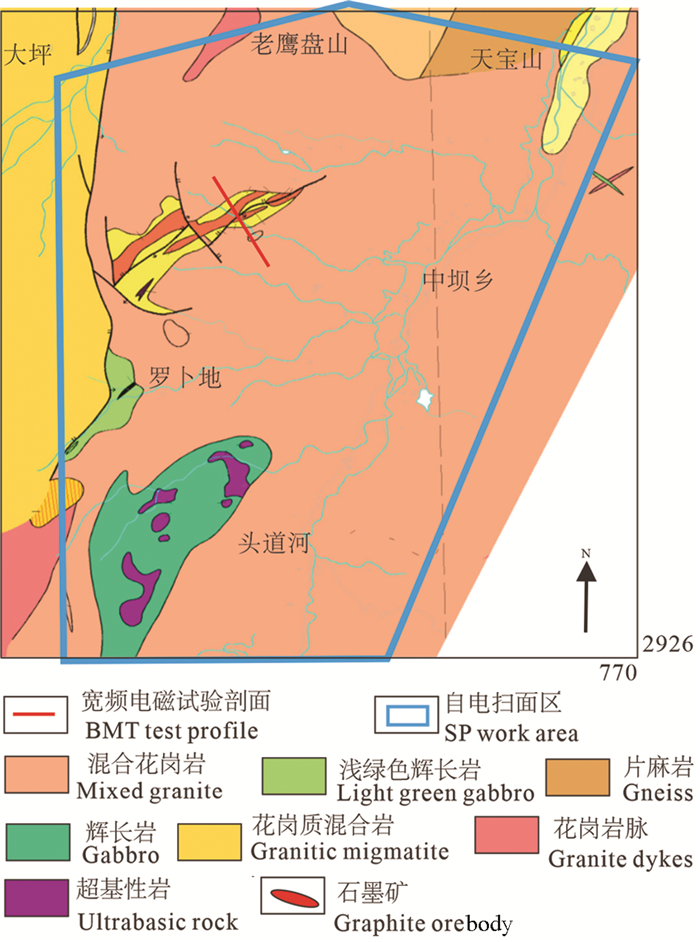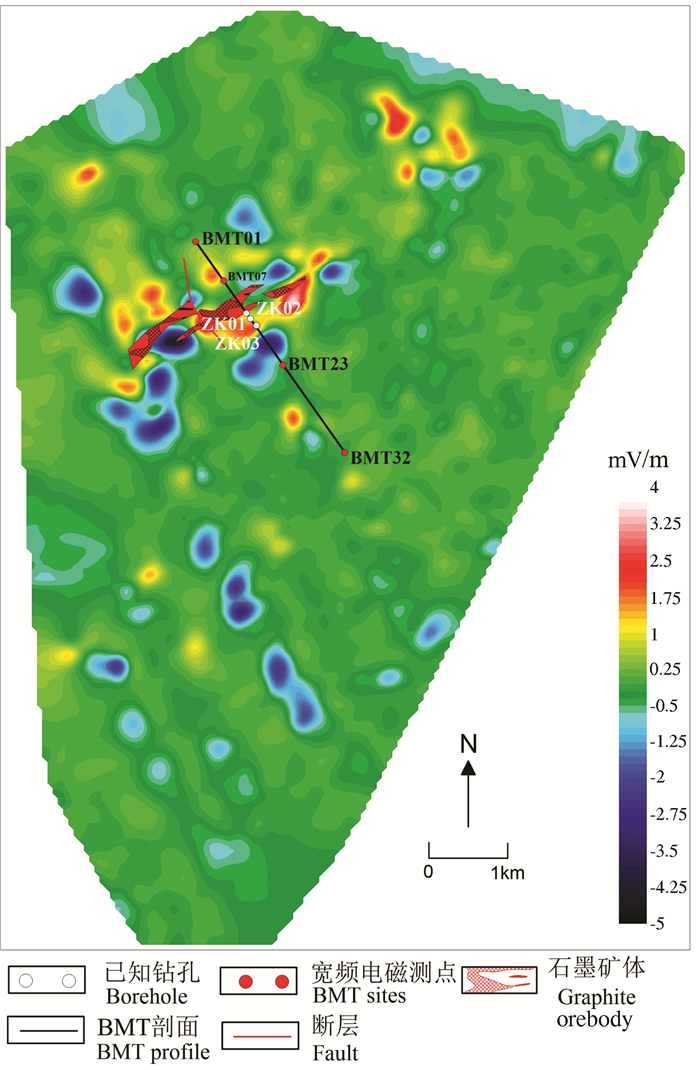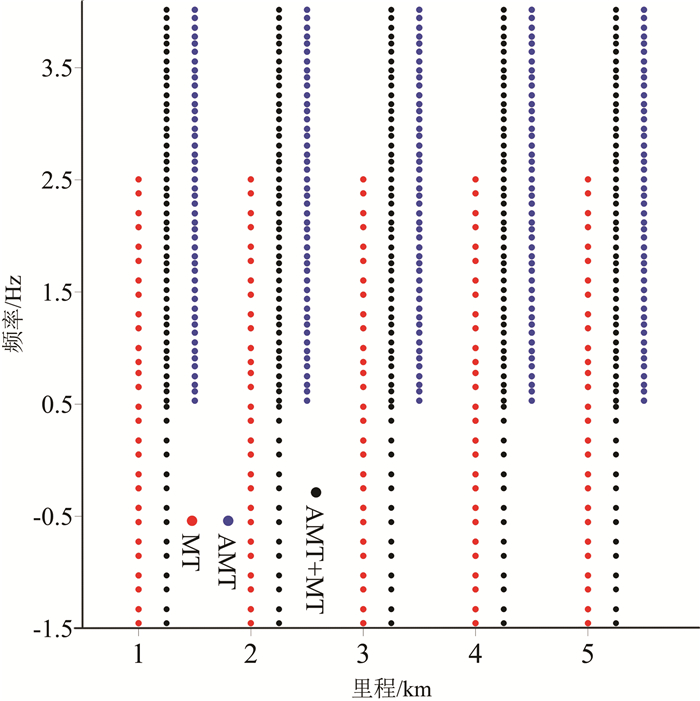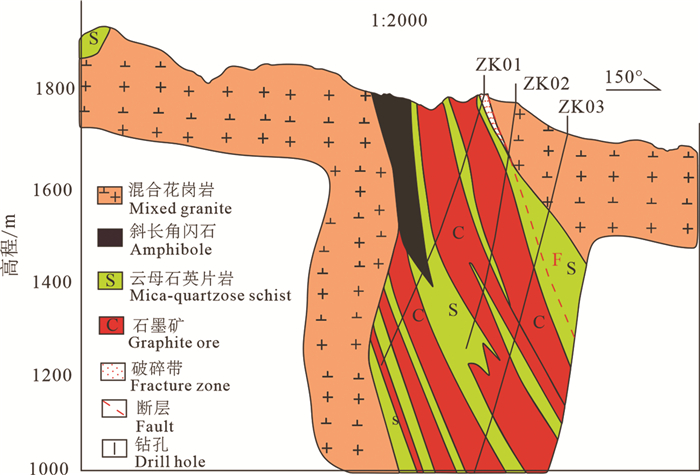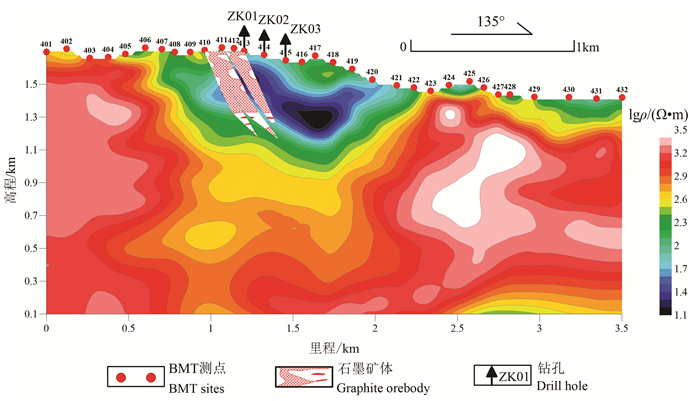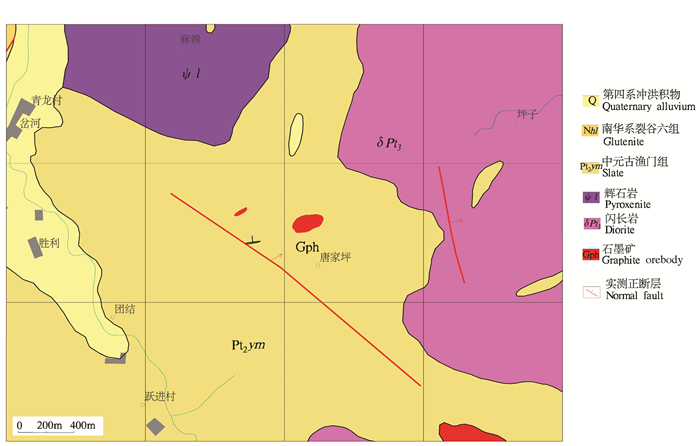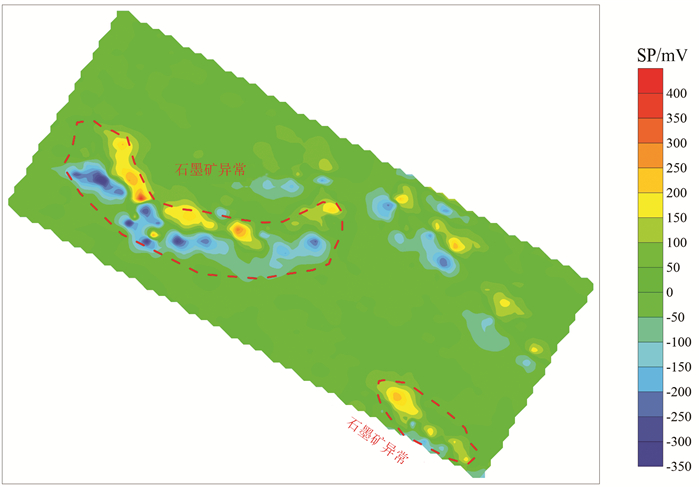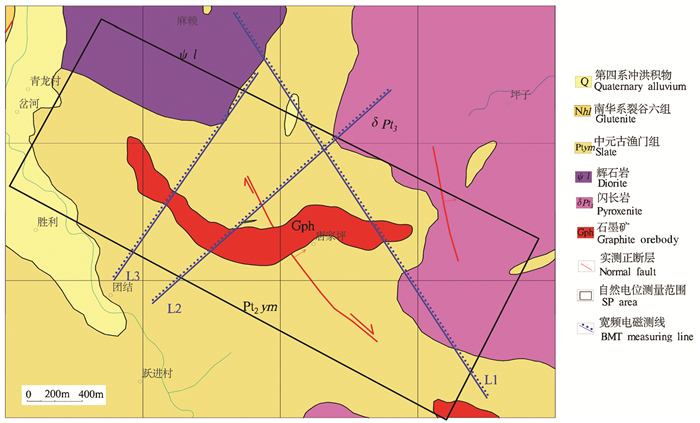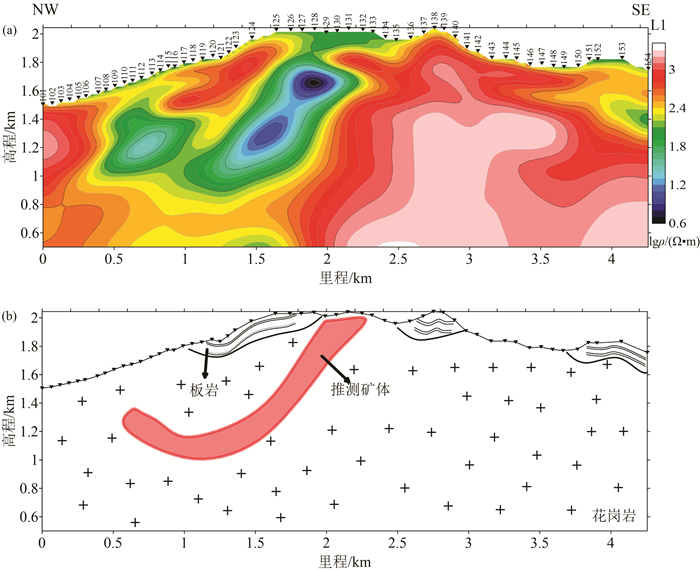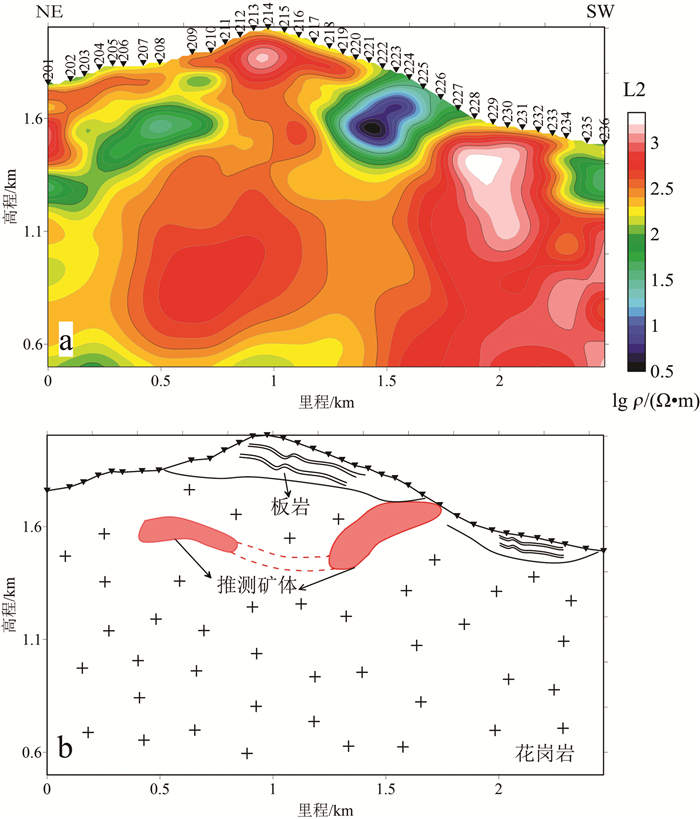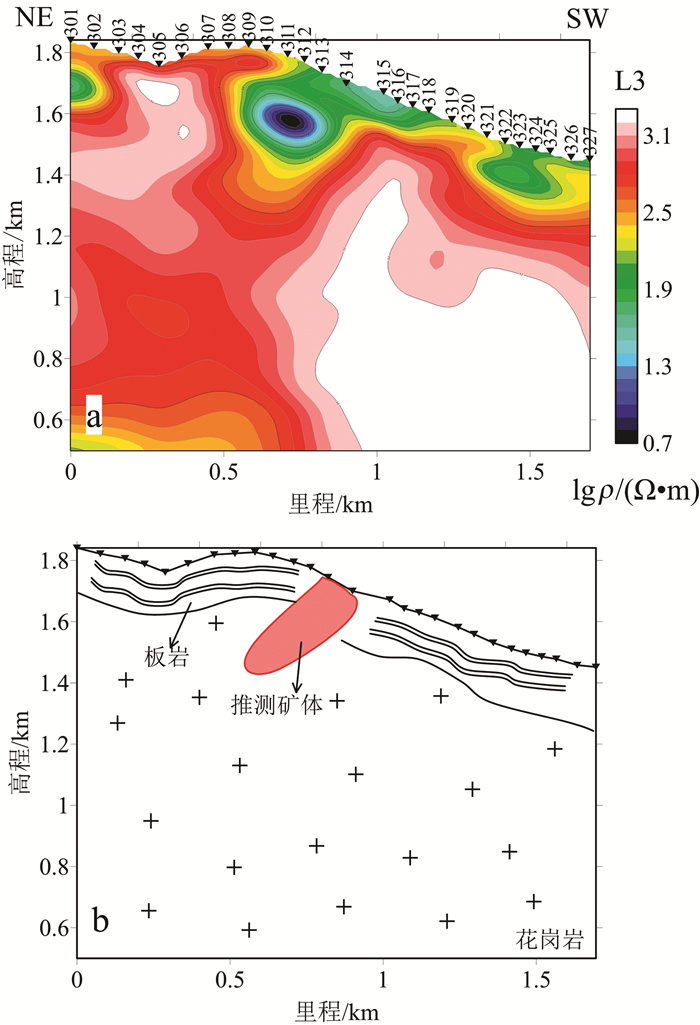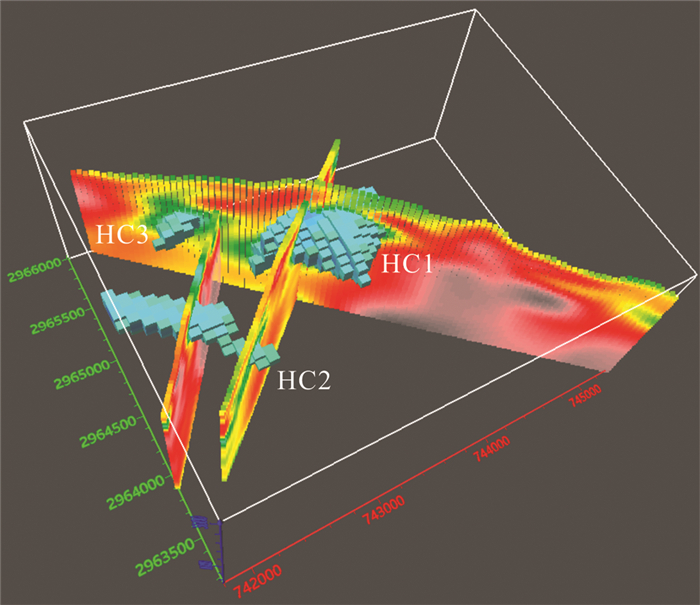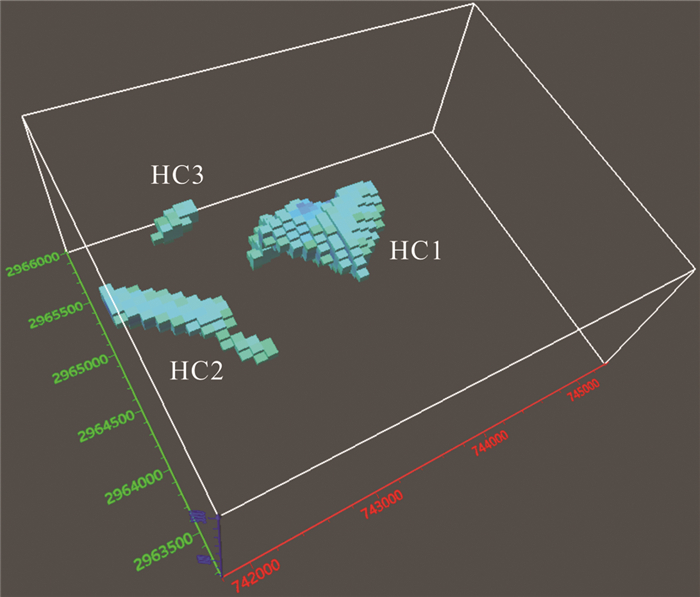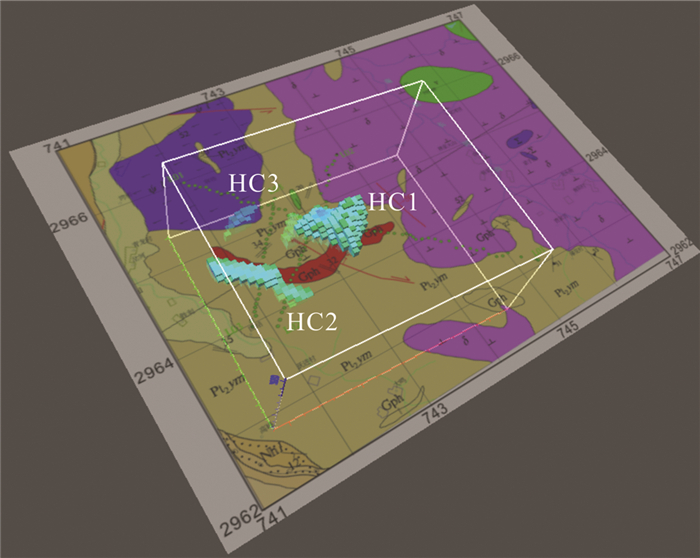Electrical characteristics and prospecting evaluation of Panzhihua crystalline graphite deposit in Sichuan Province
-
摘要:研究目的
石墨具有高的电子导电性,电性呈现形式为低阻(< 10-5Ω·m)高极化(> 40%)特征,正是由于石墨的超低阻特性,在石墨矿地球物理勘查中经常遇到"低阻屏蔽"作用,因此,优选有效的电法勘探组合在石墨矿勘查中非常重要。
研究方法本文选择四川攀枝花中坝晶质石墨矿开展正演模拟,同时对典型矿床开展自然电位法和宽频电磁法的有效性和适用性分析。
研究结果遵循"从已知到未知的原则",利用该方法组合在中坝外围唐家坪石墨矿勘查中取得了较好的应用效果,为该区矿产地评价提供了重要支撑。
结论自然电位法+宽频大地电磁测深法的组合地球物理方法能够有效圈定石墨矿地表范围及深部延展,为相似地质条件下的石墨矿勘查提供了应用示范。
创新点:正演模拟和已知石墨矿床试验结果认为自然电位法+宽频大地电磁测深法的组合地球物理方法能够有效圈定石墨矿地表范围及深部延展,可以为后期石墨矿工程勘探提供先导依据。
Abstract:This paper is the result of mineral exploration engineering.
ObjectiveGraphite, characterized by high electronic conductivity, with low resistivity (< 10-5Ω.m) and high polarization (> 40%). Due to the ultra-low resistance of graphite, "low resistance shielding" is often encountered in the geophysical exploration. Therefore, it is very important to optimize the effective geophysics methods in graphite exploration.
MethodsIn this paper, the Zhongba crystalline graphite deposit in Panzhihua, Sichuan Province is selected for forward simulation, and the effectiveness and applicability of spontaneous potential method and broadband electromagnetic method are analyzed for typical deposits.
ResultsFollowing the principle of "from known to unknown", this method has been successfully applied in the Tangjiaping Graphite exploration, which identified in the periphery of Zhongba deposit. It provides an important support for the mineral evaluation in this area.
Conclusionswe proposed a geophysical methods which synthesized the spontaneous potential method and the broadband magnetotelluric sounding method, which can effectively delineate the graphite orebody extension at surface and underground.At the same time, it provides an application demonstration for graphite exploration under similar geological conditions.
-
1. 引言
石墨为灰黑色不透明非金属矿物,具有多种优良的理化特性,素有“黑金子”的美称,在高科技领域具有广泛的用途(Bai et al., 2015)。在地质学研究领域,石墨的出现对揭示早期生命活动(Ueno et al., 2002;Schiffbauer et al., 2007)、探究地球深部圈层结构(Glassley,1982)、解析构造变形与变质作用特征(Upton et al., 2008;Oohashi et al., 2012)、追索成矿流体演化过程(Pitcairn et al., 2005)等同样能够发挥重要作用。石墨晶体的碳原子层状结构和化学键特点决定了石墨的低阻、高极化电性特征(黄伯钧,1987),并且在成矿后往往具有稳定的层位和一定的规模,因此电法勘探广泛应用于石墨矿找矿勘查中(仇勇海,1997)。而在电法勘查方法选择中由于石墨具有很强的电子导电性并且化学性质稳定,能够形成很强的自然电场,利用自然电场法、大地电磁法在勘查中取得较好的效果(胡耀星等,2015)。但是,由于石墨的超低阻特性,在地表广泛出露石墨矿地段使得大地电磁法常常受到“低阻屏蔽”作用。本文通过在攀西中坝变质型晶质石墨矿已知矿床电法试验,提出自然电位法+宽频大地电磁测深法,有效克服了石墨矿“低阻屏蔽”和勘探深度问题,并利用该组合方法在中坝外围唐家坪石墨矿远景区开展了找矿实践,结合地质资料,对唐家坪石墨矿电性异常进行综合解译取得了较好的找矿效果,为今后寻找同类石墨矿床提供参考依据。
2. 岩矿石物性特征
地球物理勘探是以地壳中地层岩石存在物性差异为前提条件的,物性参数是联系地下地质体与地球物理场的“桥梁”,是物探资料地质解释的重要依据(王建等,2004;张文浩等,2019),因此,开展物性研究是地球物理资料处理解释过程中十分重要的基础工作。
物性标本采自于区域地质调查攀枝花市幅内,基本控制了该工区的主要岩体、不同地层单元、矿化蚀变岩石、矿石。采集的岩性主要有昔格达组粉砂岩、丙南组砂砾岩岩、大荞地组泥页岩、峨眉山组玄武岩、观音崖组白云岩、石墨矿等共计184块,测量采用的是加拿大生产的SCIP样品岩心IP测试仪,测量参数电阻率和极化率,详见表 1。
表 1 攀枝花地区岩(矿)石电性统计Table 1. Statistics of physical parameters of rocks in Panzhihua
通过物性统计可知,本区白云岩、大理岩电阻率最大,变化范围在4114~8831 Ω · m,均值5641.6 Ω·m。花岗岩的电阻率都较大,变化范围在4947~1037.84 Ω· m,均值2121.7 Ω· m。玄武岩电阻率中等,变化范围678~2725 Ω· m,均值1605.1 Ω· m,超基性岩(辉长岩)电阻率变化范围244.26~1557 Ω· m,均值1542.3 Ω·m,砂砾岩电阻率较低,变化范围633~1822 Ω· m,均值802.8 Ω· m,石墨矿电阻率最低,均值145.9 Ω· m。以岩石和地层的电性特征为主,进行综合物性分层,其综合物性分层及物性变化规律见表 1和图 1。
3. 数值模拟分析
3.1 大地电磁法正演模拟
在上述物性基础下,通过正演数值模拟石墨矿的电性特征,包括自然电位响应和大地电磁响应。正演是通过给定初始模型及边界条件求解理论场值。解析法、模型实验法和数值模拟法是3种常见的由模型到响应场值过程的方法。其中数值模拟法具有超强的计算优势,应用最广泛,可分为两大类,一类是微分方程法,包括有限差分法和有限元法;另一类是积分方程法(汤井田等,2007)。本文采用的是有限单元法进行数值模拟,频率分布320 Hz-1000 S,以从理论上,分析测试大地电磁测深方法对石墨矿地质模型的响应有效性(于鹏等,2003;董浩等,2012)。
攀枝花地区的石墨矿地质条件相对较为简单,主要的围岩是花岗岩类等岩石,其中石墨矿的产状大于50°,呈高陡产出。该区物性显示,花岗岩平均电阻率为2510 Ω·m,属于高阻,石墨矿平均电阻率为21 Ω·m,属低阻。根据攀枝花地区石墨矿地质条件,建立了大地电磁的正演理论模型,如图 2a、d所示。
模型a为高陡产出的石墨矿模型,b、c分别为模型a大地电磁测深正演的视电阻率及相位拟断面图。从图 2b、c看出,大地电磁正演响应良好,对高陡石墨矿有好的反应。ρ1电阻率为5 Ω·m,低阻,代表石墨矿。ρ2电阻率为1000 Ω·m,高阻,代表花岗岩围岩。两个模型选取的电阻率都是低于实际测量的物性值的,这样的模型设置更能突显大地电磁的分辨率问题。石墨矿所代表的低阻体与高阻的围岩界面清晰,梯度带分明,且蓝色的梯度带示意了石墨矿的模型响应。大地电磁正演数据没有受到地表低阻体的影响,并未形成静态效应。0.1 Hz左右,低阻的基本封闭了,说明只要有足够低的频率,是可以揭示石墨矿底界面的埋深的,同时,这在一定程度上,表明足够低的频段大地电磁测深可以克服低阻的屏蔽作用,避免“挂面条”现象的静态效应。
模型d为垂直产出的石墨矿模型,e,f分别为模型d大地电磁测深正演的视电阻率及相位拟断面图(图 2)。从图 2e、f可看出,视电阻率受地表低阻体影响出现了挂面条现象,即静态效应,相位并没有因此受到影响。通过相位的校正参考,数据是有效的,仍然对直立的板状石墨矿有良好的反映。
通过上面两个模型的正演试算,不难看出:理论上,通过大地电磁测深方法可以有效的揭示低阻的石墨矿的埋深及规模等特征。
3.2 自然电位法正演模拟
在一般情况下物质都是电中性的,即正、负电荷保持平衡。但在一定条件下,某些物质或系统的正、负电荷会彼此分离,偏离平衡状态,通常称这种现象为“极化”。某些岩石和矿石在特定的自然条件下会呈现出极化状态,并在其周围形成自然电场,这便是岩、矿石的自然极化。由于自然电场是岩矿石本身产生的外在电场,不是特有的地球物理属性,只能用电子导电矿体的自然极化及自然电场表征产生的自然电位的大小。
在导体外电流自下而上,从地面上看,自然电流由四面八方流向导体,因此离导体越近电位越低。在导体正上方电位最低,称为自然电位负心(图 3)。通常,在硫化金属矿上可观测到几十到五百毫伏的自然电位负异常;而在石墨化程度较高的地层或石墨矿上,自电负异常的幅度可达-800~-900 mV,甚至更大,因此自然电位法是石墨矿勘探的重要方法。
根据板状体自然电位原理,从理论上正演计算出了不同产状倾角板状体自然电位特征响应曲线(图 4),笔者发现在相同深度情况下,不同产状都会在靠近地表处产生自然电位负异常峰值,产状越陡,峰值越大,并向着倾向方向衰减变为正异常,由此可判断目标体在地表的自然电位响应和深部大致倾向。
4. 攀枝花中坝石墨矿电法试验
4.1 地质概况
中国区域变质型石墨矿床分布规律明显,主要分布在古老地台、地块周缘(李寒滨等,2014;李超等,2015;路耀祖等,2016;颜玲亚等,2018),其中扬子地台的西缘四川攀枝花是西南地区最主要的变质型石墨矿集聚区(罗茂金等,2019)。探明的中坝石墨矿是该区特大型晶质石墨矿床,矿区处北东向大田基底背斜的北西翼部,前震旦系花岗质混合岩(黑云母花岗岩、花岗片麻岩、石英闪长岩等)构成背斜核部,前震旦系康定群上部(相当于冷竹关组)地层分布于两翼。其上零星分布上震旦统灯影组、下寒武统、下二叠统及三叠系地层(图 5)。其含矿岩系为古元古代康定岩群冷竹关岩组的一套中深变质岩系,出露面积1.32 km2,岩性为白云母(绢云母)石英片岩、二云母石英片岩、石英片岩、二云母片岩等。矿体走向北东50~60°,倾向南东,倾角65~80°,走向延长2595 m,宽125~1086 m,为一单斜层构造,四周为混合花岗岩,含矿岩系呈捕掳体出现。
表 2 大地电磁相关参数表Table 2. Relevant parameter of MT
4.2 电性异常特征及解释
上述中坝石墨矿经勘探矿体地表规模已基本控制(图 5),矿体深部控制约800 m(图 8)。为了验证选用的地球物理方法的有效性,在正演模拟的基础上开展方法试验,整个工区共完成自然电位梯度测量物理点3139个,控制剖面长度182 km,控制面积60 km2。
从整个自然电位梯度平面异常图看(图 6),工区自然电位梯度波动区和平稳区较明显,按自然电位梯度异常特征、地理位置划分成:中坝自然电位梯度波动区,东北角自然电位梯度波动区,剩余自然电位梯度平稳区。其中电位梯度波动区自然电位梯度变化范围为-8~8.5 mV/m,这个区域自然电位梯度值强度相对于这个工区呈最高值,分布范围广,整个区域梯度值变化相对较为剧烈,且呈正负伴生的特征,异常总体呈现明显的北东-南西走向,与地表地质填图矿体走向一致,呈条带状,异常规模较大,异常长度约3536 m,宽约2494 m,范围略大于地表矿体出露。
从前面的物性分析,石墨矿属于良导体,电阻率低,容易造成电磁波的快速衰减,根据趋肤深度计算公式h=503(ρT)1/2,导致相同频率的平面电磁波有效勘探深度变浅,进一步造成电阻率成像分辨率不足的问题(Constable, 1987; 林长佑等, 1991; Dissanayake, 2000)。为克服这一问题,笔者采用音频大地电磁测深联合大地电磁测深探测方法,以提高石墨矿底界面的分辨率。
常规音频大地电磁测深(AMT)采集的有效频段,一般在10000-3Hz,主要针对浅层勘探(2 km以浅),采集时间约为1 h(晋光文,1991)。常规大地电磁测深(MT)采集的有效频段,一般在320-0.001 Hz,主要针对深部结构探测(10 km以下),采集时间一般在24 h以上,给出了如图 7所示的频段分布表。AMT+MT联合探测方法,采集频段10000 Hz-30S(图 7),频带连续分布控制浅到中深部,采集时间6 h,可以直接有效克服良导体导致的深部分辨率不足的问题(刘华南等,2018;王刚等,2019)。
L4线位于中坝工作区最东部,测线穿过地表已知矿体,测线方向为北西南东向,全长约3.5 km,共计32个宽频大地电磁测深测点,点距约为100 m,在矿体周围点距加密到50 m(图 9)。为了良好地反映勘探效果,矿体附近加密点距,两端稀疏,重点地区为了控制矿体的深度范围,增大了数据接收频带,显著提高了勘探的分辨率。从该剖面反演图看来,整条测线电性主要呈高阻异常,407-423号点附近浅地表电性异常为低阻体显示,深部电性显示为低阻异常带。异常形态主要表现为:高阻呈块状、低阻呈带状,高低阻异常界线清晰,常呈梯度带显示。
根据物性测试结果,推测剖面中的高阻体应该花岗岩的显示。根据已知的勘探线资料,勾绘出石墨矿的剖面分布位置,并显示标于图中。石墨矿的分布位置在L4测线410-412号点一带,钻探控制矿体深度约为800 m以浅,超出深度暂没有工程控制,音频大地电磁测深结果对底部也是有一个良好的反应,预测矿体的最大标高在700 m附近。407-410、414-422号点,浅地表一带电性异常为低阻体,推测为不完全变质的碳质物的电性显示。408-422号测点这一带低阻体被高阻体完整的圈闭,显示为石墨矿捕掳体特征。
通过上述两种方法试验结果,自然电位梯度测量有效地圈定了石墨矿地表的范围,宽频大地电磁测量有效克服了石墨矿勘探深部分辨率问题,控制了“较陡”产状石墨矿的底界面,与工程验证吻合度高。
5. 攀西唐家坪石墨矿找矿实践
5.1 地质概况
唐家坪片区晶质石墨矿位于攀西盐边与华坪县交界处。矿体均产出于盐边群渔门组内,东侧紧邻新元古代石英闪长岩。该区并未开展过大比例尺的矿床地质调查,从1∶25万区域地质调查成果来看,石墨矿体规模较小,整体呈环带状分布于岩体与围岩接触带附近(图 10)。
5.2 电性异常特征及解释
为了摸清该区石墨矿规模,矿体深部延展,利用中坝石墨矿已知矿床开展的方法试验结果,在唐家坪新发现石墨矿化线索处开展物探验证,对该地段地质体深部构造及矿化异常进行了解译。
唐家坪区块共完成自然电场法剖面测线24条,剖面长度48 km,测点共800个。自然电位梯度平面等值线基本圈定矿体平面展布与形态,结合地表地质调查重新圈定了唐家坪石墨矿的范围(图 12)。矿体赋存于盐边群渔门组砂板岩中,在空间上与东侧闪长岩表现出较明显耦合,整体呈环带状分布于岩体与围岩接触带附近,空间延伸相对稳定。主要表现为石墨矿化板岩及石墨片岩,呈似层状、透镜状,受构造作用影响,岩石结构破碎,局部产状变化明显,但整体产状相对稳定,在空间上呈北西-南东东向展布,出露面积0.47 km2,呈条、带状延伸,长度为2.4 km,厚度不稳定,地表出露宽度表现为由米级至数十米级不等,最厚处厚度近百米。矿石固定碳含量一般含量4%~10%,平均固定碳7.78%。
此外,为了获得矿体深部延展,揭示石墨矿的底界面,部署了宽频电磁测深剖面3条(图 12),点距为50 m,L1线为北西南东向,L2、L3测线为北东南西方向。
L1线共有测点66个,测线总长约为4.5 km,反演最大底界面高程0.5 km。L1线反演及解释图(图 13)显示,高阻异常分布在测线的两端(图 13a),北西向的高阻分布在101~108号测点,剖面的南东向从134~152号测点存在大套的高阻异常,这些高阻的异常主要呈不规则的块状分布,电阻率在1000 Ω·m以上。低阻体分布在107~133号点,西边的低阻体隐伏于地下,由浅至深,在124号点深度达到最大,往剖面东部,低阻体则逐渐变浅,并与127~133号点出露至地表,低阻异常的底界面封闭,该“勺”状异常与地表出露的石墨矿对照良好。
L1线根据电阻率特征结合地质资料进行解释,获得了地质解释剖面(图 13b)。红色的“勺”状条带为推测的良导体,是石墨矿,长度达1.5 km,厚度约为300 m。地表分布一些板岩块体。深部以花岗岩或混合花岗为主。
L2线共有测深点38个,测线总长约为2.5 km,反演最大底界面高程0.5 km。L2线反演及解释图(图 14)显示,中高阻异常分布在整条测线分布广泛,这些高阻的异常主要呈不规则的块状连续分布,电阻率大都在1000 Ω·m以上(图 14a)。低阻体主要有两块,其中一块分布在测线的东部202-210号点,隐伏于地下150 m。另一个低阻体分布在测线中部222~227号点,该处低阻体出露于地表与地质资料的石墨矿位置吻合,低阻异常的底界面在1.2 km处封闭,如果把这两处异常联系起来看,该异常类似于L1线的“勺”状异常。
L2线根据电阻率特征结合地质资料进行解释,获得了地质解释剖面(图 14b)。红色的“勺”状条带为推测的良导体,是石墨矿,长度达1 km,厚度约为200 m,规模可观。地表分布一些板岩块体。深部以花岗岩或混合花岗为主。
L3线共有测深点27个,测线总长约为1.7 km,反演最大底界面高程0.5 km。L2线反演及解释图(图 15)显示,高阻异常分布在整条测线分布广泛,这些高阻的异常主要呈不规则的块状连续分布,电阻率大都在1000 Ω· m以上(图 15a)。低阻体主要有3块,分布在地表300 m以浅,其中一块分布在测线的中部312~318号点,出露至地表,长度500 m,宽度约为200~300 m,到深部逐渐紧缩直至尖灭,异常形态呈板状体。另两个低阻体分布在测线两端,规模较小,并无大的找矿意义。
L3线根据电阻率特征结合地质资料进行解释,获得的地质解释剖面(图 15b)。红色的板状体为推测的良导体,是石墨矿,长度达0.5 km,厚度为200~300 m,规模可观。地表分布一些板岩块体。深部以花岗岩或混合花岗为主。
通过前期资料的处理,对唐家坪地区L1、L2及L3等三条宽频大地电磁剖面数据集成,形成三维电性模型(图 16),并提取剩余电性体(图 17)。通过资料的三维可以更直观的看到各个剖面,相应地质体的空间展布特征。
通过三维插值,获得工作区的三维电性体模型(张昆等,2019),提取了电阻率分布在1~50 Ω·m的剩余电性体模型(图 18)显示。从中可以看到,模型中分布着3个剩余电性体,分别为HC1、HC2、HC3。其中,HC1规模最大,HC2规模及埋深中等,HC3埋深最大、规模最小。
根据前面的三维剩余电性体的分布,对照地质图(转换到海拔1600 m)发现剩余电性体HC1、HC2与地表的石墨矿体有着很好的对照关系。(1)HC1规模最大。该处矿体以较大的倾角向北西方向延伸,深部延伸大,厚度大,推测与HC3贯通;(2)HC2规模中等。该矿体呈直线分布,以较大的倾角向北东方向延伸,厚度中等,埋深中等;(3)HC3规模小。推测该异常为石墨矿体,隐伏与海拔1.2~1 km处,厚度约为150 m。(4)“盆”状矿体模型。前节单剖面的解释中,L1、L2的矿体异常为“勺”状异常,再结合三维显示的结果,推测认为唐家坪石墨矿体形成之初三维结构可能呈“盆”状结构,经过后期的区域变质作用及造山作用将其改造,形成现今“地表完整、越往深部越破碎”的盆状矿体模型。
6. 结论
石墨矿特殊的低阻高极化特性使得电法勘探成为快速评价石墨矿床有效的物探手段,通过本次的方法试验和找矿实践,讨论了自然电位法和宽频电磁测深法在石墨矿勘查中的有效性,并得出以下结论:
(1)形成一套适应于四川攀枝花地区石墨矿的电法勘探模式:自然电位法扫面+重点异常区宽频大地电磁测深。通过物性参数测试分析、地球物理方法的优劣势对比优选、理论模型的正演试算以及典型矿床模型的试验(中坝)等方法的适应性分析及矿区外围(唐家坪)的调查表明:自然电位梯度测量可以清晰地揭示石墨矿的平面分布特征,宽频大地电磁可以揭露石墨矿深部的展布情况,这就为攀西石墨矿的地质填图工作及探采工作,提供了有效的地球物理依据。
(2)提出攀西唐家坪“盆”状矿床模型:“地表完整、越往深部越破碎”的“盆”状矿体模型。应用自然电位法及宽频大地电磁剖面资料与三维显示结合认为:唐家坪石墨矿体形成之初三维结构可能呈“盆”状结构,经过后期的区域变质作用及造山作用将其改造,形成现今的“盆”状矿体模型,为该区矿产地评价提供了重要支撑。
此外,通过此次研究也为相似地质条件下的石墨矿勘查提供了应用示范。
致谢: 感谢审稿老师提出的宝贵意见以及编辑部的大力支持。 -
表 1 攀枝花地区岩(矿)石电性统计
Table 1 Statistics of physical parameters of rocks in Panzhihua

表 2 大地电磁相关参数表
Table 2 Relevant parameter of MT

-
Bai Q, Zhang S T, Wang W L, Wang Z J. 2015. Variance of graphite import-export volume and price in china for 2003-2012: A time series analysis[J]. Resources Policy, 44: 65-70. doi: 10.1016/j.resourpol.2015.01.004
Constable S C, Parker R L, Constable C. 1987. A practical algorithm for generating smooth models from electromagnetic sounding data[J]. Geophysics, 52(3): 289-300. doi: 10.1190/1.1442303
Dissanayake C B, Chandrajith R, Boudou J P. 2000. Biogenic graphite as a potential geomarker -Application to continental reconstructions of Pan-African Gondwana terrains[J]. Gondwana Research, 3: 405-413. doi: 10.1016/S1342-937X(05)70298-7
Dong Hao, Wei Wenbo, Ye Gaofeng, Jin Sheng, Jin Jianen, Zhang Letian, Zhang Fan, Xie Chenliang. 2012. Study of two dimensional magnetotelluric inversions of complex three dimensional structures[J]. Chinese J. Geophys, 55(12): 4003-4014 (in Chinese with English abstract).
Glassley W. 1982. Fluid evolution and graphite genesis in the deep continental crust[J]. Nature, 295: 299-231. doi: 10.1038/295299a0
Hu Yaoxing, 2015. Application of comprehensive electrical methodin the Jamming area of graphite ore deposit[J]. China non-metallic minerals industry, 4: 29-33(in Chinese with English abstract). http://en.cnki.com.cn/Article_en/CJFDTotal-LGFK201504010.htm
Huang Bojun. 1986. Graphitization of carbonaceous material in metamorphic rocks[J]. Acta Mineralogica Sinica, 6(4): 350-355(in Chinese with English abstract).
Jiang Gaozhen, Li Yike, Wang Anjian, Yang Xuan. 2017. Genetic features of Dawudian graphite deposit in Urad Middle Banner, Inner Mongolia[J]. Earth Science Frontiers, 5(24): 307-316(in Chinese with English abstract). http://en.cnki.com.cn/Article_en/CJFDTotal-DXQY201705032.htm
Jin Guangwen. 1991. A sensitivity study on magnetotelluric data[J]. Acta Geophysica Sinica, 4: 465-473(in Chinese with English abstract).
Li Chao, Wang Denghong, Zhao Hong. 2015. Minerogenetic regularity of graphite deposits in China[J]. Mineral Deposits, 34(6): 1223-1236(in Chinese with English abstract).
Li Hanbin, Zhang Bing. 2015. Metamorphism and its significance of Yunshan graphite deposit in Heilongjiang[J]. China Non-metallic Minerals Industry, 1: 45-46(in Chinese with English abstract). http://en.cnki.com.cn/Article_en/CJFDTOTAL-LGFK201401017.htm
Lin Changyou, Wu Yuxia. 1991. On the joint inversion of Magnetotelluric data[J]. Northwestern Seismological Journal, 2(13): 8-20(in Chinese with English abstract). http://en.cnki.com.cn/Article_en/CJFDTOTAL-ZBDZ199102001.htm
Liu Huanan, Liu Jiajun, Li Xiaowei, Liu Chonghao, Dai Hongzhang, Tao Yinlong, Wang Jianfeng, Du Yingdong, Fan Yunfei. 2018. Thermoelectric characteristics of pyrite from the Xindigou gold deposit in Inner Mongolia and its significance on deep prospecting[J]. Geology in China, 45(4): 819-838(in Chinese with English abstract).
Lu Yaozu, Shi Guocheng. 2016. Geological characteristics and genersis analysis of graphite deposit in South Mountain of Datonggou region, Qinghai Province[J]. Journal of Qinghai University(Natural Science Edition), 2(34): 54-59(in Chinese with English abstract). http://en.cnki.com.cn/Article_en/CJFDTOTAL-QHXZ201602010.htm
Luo Maojin, Ma Zhixin, Sun Zhiming, Huang Teng, Ren Jingwei, Jiang Yan. 2019. Crystalline-basement crystalline graphite deposit dataset on the northern margin of the Upper Yangtze and North Sichuan[J]. Geology in China, 46(S1): 39-45(in Chinese with English abstract).
Oohashi K, Hirose T, Kobayashi K, Shimamoto T. 2012. The occurrence of graphite-bearing fault rocks in the Atotsugawa fault system, Japan: Origins and implication for fault creep[J]. Journal of Structural Geology, 38: 39-50. doi: 10.1016/j.jsg.2011.10.011
Pitcairn I K, Roberts S, Teagle D A H, Crow D. 2005. Detecting hydrothermal graphite deposition during metamorphism and gold mineralization[J]. Journal of the Geological Society, London, 162: 429-432. doi: 10.1144/0016-764904-139
PoubaZ, Kříbek B, 1986. Organic matter and the concentration of metals in Precambrian stratiform deposits of the Bohemian Massif[J]. Precambrian research, 33: 225-237. doi: 10.1016/0301-9268(86)90023-9
Qiu Gengen, Fang Hui, Lü Qinyin, Peng Yan. 2019. Deep electrical structures and metallogenic analysis in the north section of Wuyishan Mountains and its adjacent areas: Based on three-dimensional magnetotelluric sounding results[J]. Geology in China, 46(4): 775-785(in Chinese with English abstract).
Qiu Yonghai, Chen Baizhen. 1997. Electrochemistry mechanism of induced polarization of graphite ore[J]. The Chinese Journal of Nonferrous Metals, 3(7): 6-9(in Chinese with English abstract).
Schiffbauer J D, Yin L, Bodnar R J, Kaufman A J, Meng F, Hu J, Shen B, Yuan X, Bao H, Xiao S. 2007. Ultrastructural and geochemical characterization of Archean-Paleo-proterozoic graphite particles: Implication for recognizing traces of life in highly metamorphosed rocks[J]. Astrobiology, 7(4): 684-704. doi: 10.1089/ast.2006.0098
Smith J T, Booker J R, 1991. Rapid inversion of two-and three-dimensional magnetotelluricdata[J]. J. Geophys, 96(B3): 3905-3922. doi: 10.1029/90JB02416
Tang Jingtian, Ren Zhengyong, Hua Xirui. 2007. The forward modeling and inversion in geophysical electromagnetic field[J]. Progress in Geophysics, 22(4): 1181-1194(in Chinesewith English abstract).
Ueno Y, Yurimoto H, Yoshioka H, Komiya T, Maruyama S. 2002. Ion microprobe analysis of graphite from ca. 3.8 Ga metasediments, Isuasupracrustal belt, West Greenland: Relationship between metamorphism and carbon isotopic composition[J]. Geochimica et Cosmochimica Acta, 66(7): 1257-1268. doi: 10.1016/S0016-7037(01)00840-7
Upton P, Craw D. 2008. Modelling the role of graphite in development of a mineralised mid-crustal shear zone, Macraes mine, New Zealang[J]. Earth and Planetary Science Letters, 266(3/4): 245-255. https://www.sciencedirect.com/science/article/abs/pii/S0012821X0700698X
Wang Gang, Fang Hui, Qiu Gengen, Huang Jimin. 2019. The deep electrical structure across Anqing-Guichi ore concentration area[J]. Geology in China, 46(4): 795-806(in Chinese with English abstract). http://en.cnki.com.cn/Article_en/CJFDTotal-DIZI201904011.htm
Wang Jian, Lü Chengyuan, Hu Yonghua, Sun Zhigang. 2004. Experiment of rock resistivity under formation conditions[J]. Petroleum Exploration and Development, 13(1): 113-115. http://en.cnki.com.cn/Article_en/CJFDTOTAL-SKYK200401036.htm
Yan Lingya, Gao Shuxue, Chen Zhengguo, Jiao Lixiang, Sun Li, Liu Yanfei, Zhou Wen. 2018. Metallogenic characteristics and metallogenic zoning of graphite deposits in China[J]. Geology in China, 45(3): 421-440(in Chinese with English abstract). http://en.cnki.com.cn/Article_en/CJFDTotal-DIZI201803002.htm
Yu Peng, Wang Jialin, Wu Jiansheng, Zhang Donglun. 2003. Improving inversion resolution by using new definition of magnetotelluric apparent resistivity[J]. Journal of Tongji University, 4(31): 418-423.
Zhang Kun, Lü Qingtian, Yan Jiayong, Zhao Jinhua. 2019. The three-dimensional electrical characteristics of the typical iron and copper deposits in the Lujiang-Zongyang ore concentration area[J]. Geology in China, 46(4): 807-817(in Chinese with English abstract).
Zhang Wenhao, Wang Dandan, Li Shizhen, Zhou Xingui, Zhang Jiaodong, Liu Weibin, Zhou Ximing, Wang Peiye. 2019. The application of gravity-magnetic-electric prospecting engineering for Carboniferous-Permian petroleum geological survey in Sanjiang Basin, Heilongjiang Province[J]. Geology in China, 46(1): 191-202(in Chinese with English abstract).
仇根根, 方慧, 吕琴音, 彭炎. 2019. 武夷山北段及相邻区深部电性构造与成矿分析: 基于三维大地电磁探测结果[J]. 中国地质, 46(4): 775-785. http://geochina.cgs.gov.cn/geochina/ch/reader/view_abstract.aspx?file_no=20190408&flag=1 仇勇海, 陈白珍, 1997. 石墨矿的激发极化电化学机理[J]. 中国有色金属学报, 3(7): 6-9. 董浩, 魏文博, 叶高峰, 金胜, 景建恩, 张乐天, 张帆, 谢成良. 2012. 大地电磁测深二维反演方法求解复杂电性结构问题的适应性研究[J]. 地球物理学报, 55(12): 4003-4014. doi: 10.6038/j.issn.0001-5733.2012.12.012 胡耀星. 2015. 综合电法在干扰区石墨矿勘查中的应用[J]. 中国非金属矿工业导刊, 4: 29-33. https://www.cnki.com.cn/Article/CJFDTOTAL-LGFK201504010.htm 黄伯钧. 1986. 变质岩中碳质物质的石墨化作用[J]. 矿物学报, 6(4): 350-355. doi: 10.3321/j.issn:1000-4734.1986.04.010 姜高珍, 李以科, 王安建, 杨轩, 杨彪, 马莉. 2017. 内蒙古乌拉特中旗大乌淀石墨矿成因特征分析[J]. 地学前缘, 5(24): 307-316. 晋光文. 1991. 大地电磁资料的灵敏度研究[J]. 地球物理学报, 4: 465-473. doi: 10.3321/j.issn:0001-5733.1991.04.007 李超, 王登红, 赵鸿, 裴浩翔, 李欣蔚, 周丽敏, 杜安道, 屈文俊. 2015. 中国石墨矿床成矿规律概要[J]. 矿床地质, 34(6): 1223-1236. https://www.cnki.com.cn/Article/CJFDTOTAL-KCDZ201506011.htm 李寒滨, 张冰. 2014. 黑龙江云山石墨矿床变质作用及其意义[J]. 中国非金属矿工业导刊, 1: 45-46. 林长佑, 武玉霞. 1991. 大地电磁测深资料的联合反演研究[J]. 西北地震学报, 2(13): 8-20. https://www.cnki.com.cn/Article/CJFDTOTAL-ZBDZ199102001.htm 刘华南, 刘家军, 李小伟, 刘冲昊, 代鸿章, 陶银龙, 王建锋, 杜映东, 范云飞. 2018. 内蒙古新地沟金矿床黄铁矿热电性特征及深部找矿意义[J]. 中国地质, 45(4): 819-838. http://geochina.cgs.gov.cn/geochina/ch/reader/view_abstract.aspx?file_no=20180412&flag=1 路耀祖, 石国成. 2016. 青海大通沟南山石墨矿床地质特征及其成因分析[J]. 青海大学学报(自然科学版), 2(34): 54-59. https://www.cnki.com.cn/Article/CJFDTOTAL-QHXZ201602010.htm 罗茂金, 马志鑫, 孙志明, 黄腾, 任京伟, 姜岩. 2019. 上扬子北缘川北地区结晶基底晶质石墨矿数据集[J]. 中国地质, 46(S1): 39-45. doi: 10.12029/gc2019Z105 汤井田, 任政勇, 化希瑞. 2007. 地球物理学中的电磁场正演与反演[J]. 地球物理学进展, 22(4): 1181-1194. doi: 10.3969/j.issn.1004-2903.2007.04.025 王刚, 方慧, 仇根根, 黄继民. 2019. 安庆-贵池矿集区及邻区深部电性结构研究[J]. 中国地质, 46(4): 795-806. http://geochina.cgs.gov.cn/geochina/ch/reader/view_abstract.aspx?file_no=20190410&flag=1 王建, 吕成远, 胡永华, 孙志刚. 2004. 地层条件下岩石电性特征实验研究[J]. 石油勘探与开发, 13(1): 113-115. doi: 10.3321/j.issn:1000-0747.2004.01.036 颜玲亚, 高树学, 陈正国, 焦丽香, 孙莉, 刘艳飞, 周雯. 2018. 中国石墨矿成矿特征及成矿区带划分[J]. 中国地质, 45(3): 421-440. http://geochina.cgs.gov.cn/geochina/ch/reader/view_abstract.aspx?file_no=20180301&flag=1 于鹏, 王家林, 吴健生, 张东伦. 2003. 利用MT新的视电阻率定义提高反演分辨率[J]. 同济大学学报, 4(31): 418-423. https://www.cnki.com.cn/Article/CJFDTOTAL-TJDZ200304010.htm 张昆, 吕庆田, 严加永, 赵金花. 2019. 安徽庐江-枞阳矿集区典型铜、铁矿床三维电性结构特征[J]. 中国地质, 46(4): 807-817. http://geochina.cgs.gov.cn/geochina/ch/reader/view_abstract.aspx?file_no=20190411&flag=1 张文浩, 王丹丹, 李世臻, 周新桂, 张交东, 刘卫彬, 周锡明, 王佩业. 2019. 重磁电勘探在黑龙江三江盆地石炭系-二叠系油气地质调查中的应用[J]. 中国地质, 46(1): 191-202. http://geochina.cgs.gov.cn/geochina/ch/reader/view_abstract.aspx?file_no=20190112&flag=1 -
期刊类型引用(2)
1. 李松柏,王亮,唐喜,朱广飞. AMT在戌街石墨矿勘查中的试验效果分析. 现代矿业. 2023(01): 14-17+21 .  百度学术
百度学术
2. 杨剑,王桥,刘伟,夏时斌,张伟,廖国忠,李华,高慧. 基于宽频大地电磁法的页岩气探测实践——以川西南沐川地区须家河组为例. 沉积与特提斯地质. 2022(03): 444-454 .  百度学术
百度学术
其他类型引用(1)



 下载:
下载:
